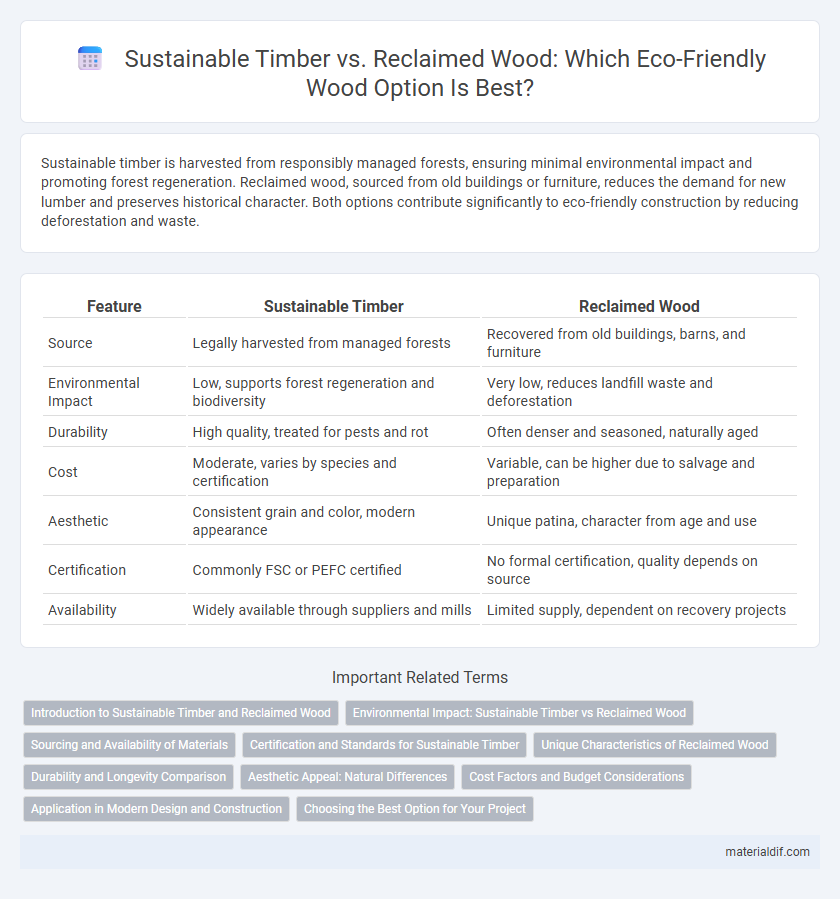Sustainable timber is harvested from responsibly managed forests, ensuring minimal environmental impact and promoting forest regeneration. Reclaimed wood, sourced from old buildings or furniture, reduces the demand for new lumber and preserves historical character. Both options contribute significantly to eco-friendly construction by reducing deforestation and waste.
Table of Comparison
| Feature | Sustainable Timber | Reclaimed Wood |
|---|---|---|
| Source | Legally harvested from managed forests | Recovered from old buildings, barns, and furniture |
| Environmental Impact | Low, supports forest regeneration and biodiversity | Very low, reduces landfill waste and deforestation |
| Durability | High quality, treated for pests and rot | Often denser and seasoned, naturally aged |
| Cost | Moderate, varies by species and certification | Variable, can be higher due to salvage and preparation |
| Aesthetic | Consistent grain and color, modern appearance | Unique patina, character from age and use |
| Certification | Commonly FSC or PEFC certified | No formal certification, quality depends on source |
| Availability | Widely available through suppliers and mills | Limited supply, dependent on recovery projects |
Introduction to Sustainable Timber and Reclaimed Wood
Sustainable timber is harvested from responsibly managed forests that maintain biodiversity, productivity, and ecological processes, ensuring long-term environmental health. Reclaimed wood comes from salvaged sources such as old buildings, barns, and factories, offering a renewable resource by repurposing existing materials and reducing waste. Both options significantly minimize deforestation impacts, promote carbon sequestration, and support environmentally friendly construction practices.
Environmental Impact: Sustainable Timber vs Reclaimed Wood
Sustainable timber involves responsible forest management practices that ensure regeneration and minimize deforestation, leading to a reduced carbon footprint and preservation of biodiversity. Reclaimed wood, sourced from repurposed materials, significantly lowers environmental impact by diverting waste from landfills and reducing the demand for new logging. Both options contribute to eco-friendly construction, but reclaimed wood typically offers greater carbon savings by extending the lifecycle of existing resources.
Sourcing and Availability of Materials
Sustainable timber is sourced from responsibly managed forests certified by organizations like FSC and PEFC, ensuring continuous regrowth and minimal environmental impact. Reclaimed wood comes from salvaged materials such as old buildings and barns, offering limited but unique availability that depends on demolition projects and local supply. Both options support eco-friendly practices, but sustainable timber offers more consistent availability, while reclaimed wood emphasizes material reuse and historical character.
Certification and Standards for Sustainable Timber
Certified sustainable timber adheres to rigorous standards such as FSC (Forest Stewardship Council) and PEFC (Programme for the Endorsement of Forest Certification), ensuring responsible forest management and reduced environmental impact. These certifications verify that timber is sourced legally, promotes biodiversity, and safeguards indigenous rights. Reclaimed wood, while eco-friendly through reuse, lacks formal certification frameworks, relying instead on documentation of origin and treatment to assure quality and sustainability.
Unique Characteristics of Reclaimed Wood
Reclaimed wood stands out for its rich history and unique character, showcasing varied textures, patinas, and weathering that new timber cannot replicate. It often features visible nail holes, knots, and grain patterns developed over decades, contributing to a distinctive aesthetic with inherent sustainability benefits. This wood's durability and seasoned nature make it a preferred choice for eco-conscious builders seeking authentic material with a story.
Durability and Longevity Comparison
Sustainable timber, sourced from responsibly managed forests, offers consistent durability with treatments enhancing resistance to decay and pests, ensuring longevity that meets building standards. Reclaimed wood, often aged and naturally seasoned over decades, can surpass new timber in durability due to its dense grain and reduced moisture content, but may require careful inspection for hidden damage like nails or rot. Both materials promote environmental benefits, yet reclaimed wood's extended lifecycle contributes intrinsically to sustainable construction through material reuse and conservation of forest resources.
Aesthetic Appeal: Natural Differences
Sustainable timber showcases a consistent grain pattern and uniform color due to controlled harvesting and processing methods. Reclaimed wood features unique textures, weathered patinas, and natural imperfections developed over decades, adding character and historic charm. These natural differences make sustainable timber ideal for modern aesthetics, while reclaimed wood suits rustic and vintage designs.
Cost Factors and Budget Considerations
Sustainable timber typically involves higher upfront costs due to responsible harvesting practices and certification fees, but it ensures long-term environmental benefits and regulatory compliance. Reclaimed wood often reduces immediate material expenses by salvaging existing wood, though additional costs may arise from processing, cleaning, and treating to meet quality standards. Budget considerations should weigh short-term savings with reclaimed wood against the predictable investment and eco-friendly credentials of sustainable timber.
Application in Modern Design and Construction
Sustainable timber offers a reliable, eco-friendly source of wood that supports forest conservation while meeting the demands of modern construction with consistent quality and availability. Reclaimed wood provides unique character and historical value, making it ideal for accent pieces and distinctive architectural details in contemporary design. Both materials contribute to reducing carbon footprints, but sustainable timber is favored for large-scale projects due to its predictable supply and certification standards.
Choosing the Best Option for Your Project
Sustainable timber, sourced from responsibly managed forests certified by organizations like FSC or PEFC, ensures a renewable supply with minimal environmental impact. Reclaimed wood offers unique character and reduces landfill waste by repurposing existing materials, but may require more processing to meet specific project standards. Evaluating project requirements, environmental goals, and budget constraints helps determine whether sustainable timber or reclaimed wood is the optimal choice.
Sustainable Timber vs Reclaimed Wood Infographic

 materialdif.com
materialdif.com